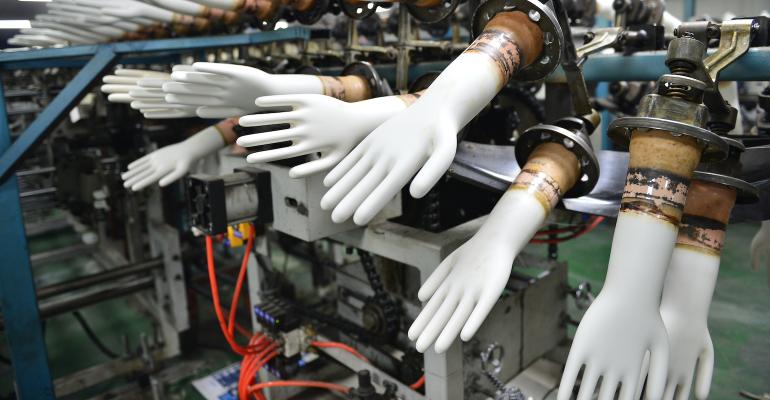The COVID-19 pandemic has led to a worldwide surge in demand for protective gloves, among other PPE, and countries such as Malaysia, constituting 60 percent of the global market, have been quick to respond.
In September 2020, the world’s leading rubber glove manufacturer Top Glove, headquartered outside Malaysia’s capital, reported a 417 percent increase in fiscal 2020 post-tax profit from the previous year. Top Glove expects up to 30 percent additional growth for 2021.
While there are signs of the pandemic abating in early 2021, expectations in the rubber glove industry remain high.
MARGMA (Malaysian Rubber Glove Manufacturers Association), the industry association representing local glove makers, believes that post-pandemic demand will continue to be buoyant – indeed bigger compared to pre-Covid times – at 15-20 percent growth per annum.
Speaking to Omnia Health Insights, MARGMA president Dr Supramaniam Shanmugam cited several factors.
First, changes are expected in individuals' personal behaviour. Many people worldwide will remain cautious after the pandemic “to the point of being fearful”, wary of the emergence of another global health crisis or infectious disease.
Second, businesses dealing with people will likely also remain cautious. With the resumption of air travel and commercial cruises at "normal" levels, many staff will continue to wear protective gloves when interacting with the public.
Glove demand will come from care homes too – this will be further fueled by a rise in ageing populations worldwide.
Voluntary behaviours aside, Dr Supra added, governments will enforce new regulations mandating the use of gloves.
Lastly, adding to the optimism is the emergence of China and India, two enormous markets with a rapidly growing middle class.
Trust and innovation underpin Malaysia’s rubber glove success
While China in itself has the means to manufacture gloves – synthetic, in particular, rather than latex – Malaysia has a head start of three decades, allowing it to establish sales and marketing entrepreneurship.
Companies such as Top Glove command great loyalty because of their many years of experience, Dr Supra highlighted.
Malaysia is expected to remain competitive for another reason: innovation.
Robotics and automation are prevalent in Malaysia’s rubber glove industry, according to the MARGMA president.
While in the past it took 10 workers to produce a million pieces of glove per month, today that figure has been reduced to 1.7 as a result of big data, AI and other innovations. Similarly, in the 1980s, 3,000 gloves per hour were manufactured. Today through more modern production lines, 45,000 pieces roll off every hour.
The industry is also committed to innovation in the form of alternative energy and sustainability. Glove manufacturers today consume a high quantity of water – a “depleting resource” in Malaysia.
Finally, there is innovation in the form of chemistry, resulting in the production of ever thinner natural rubber gloves. The entry point of a rubber glove is 5.5g, Dr Supra revealed, with work ongoing to bring this down to 4g.
A socially responsible industry
Social compliance and stakeholder engagement are critical to Malaysia’s rubber glove journey: social responsibility checks are conducted by international businesses buying gloves from Malaysia.
Currently the domestic rubber glove industry is 70 percent socially compliant, with the remainder “on its way,” Dr Supra explained.
To further assist the industry, the Malaysian government has come up with a grant to enable rubber glove makers to register with social compliance programme SEDEX (Supplier Ethical Data Exchange), an international collaborative platform for sharing responsible sourcing data on supply chains.
MARGMA is also communicating updates on the industry’s social compliance initiatives to international governments through embassies and other bodies.
Many governments are appreciative of Malaysia’s efforts in supporting countries worldwide in the pandemic through the nation’s rubber glove production, Dr Supra said.
Exports approaching normal after delays
Malaysia’s rubber glove manufacturers have faced a problem recently in the form of disrupted container supply chains, following increased demand before Christmas from the US and Europe.
Vessels travelled between the US, Europe and China without opportunity to call at Malaysia at the end of 2020 and beginning of 2021, resulting in export delays. Dr Supra expects normality to resume “at the end of March”.
While a number of businesses have diversified into rubber glove manufacturing, seizing the opportunity presented by the pandemic, it’s not thought they will add significantly to supply.
From the dozen or so new entrants, only a small number have established production lines to roll out gloves in 2021. These will amount to fewer than 10 billion pieces this year, a drop compared to the 280 billion produced overall in 2020.
The vast majority of Malaysia’s additional supply of rubber gloves will come from the established players who have been aggressively expanding since 2019.

